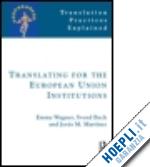Chapter 1 – Why we translate Multilingualism: the principleEquality before the lawCitizenship of the UnionLegal basis of multilingualism Language versions or translations?Three common myths about multilingualism Exercises for students Chapter 2 – The EU institutions: their roles and their translation services How the EU institutions interactThe European CouncilThe European ParliamentThe Council of the European UnionThe European CommissionThe Court of Justice of the European UnionThe European Court of AuditorsThe European Central BankThe European OmbudsmanThe European Data Protection SupervisorFinancial bodies The European Investment Bank The European Investment Fund Advisory bodies The Economic and Social Committee The Committee of the Regions Joint Services of the Economic and Social Committee and the Committee of the RegionsInterinstitutional bodies European External Action service (EEAS) Publications Office of the European Union European Personnel Selection Office (EPSO) Eurostat European Administrative School Agencies Common Security and Defence Policy Agencies Police and judicial cooperation in criminal matters Other policy areas (‘Community’ agencies) Executive agencies EURATOM agencies and bodies 28 European Institute of Innovation and Technology (EIT) 28The Translation Centre An afterthoughtExercises for students Chapter 3 – How to get in Working in-house for the EU institutions Recruitment EPSO recruitment competitions for permanent translatorsCompetition in two phases General conditions of eligibility for permanent translators Success rates in recent translators’ competitionsNon-permanent staff: Temporary translators and contract agentsWorking for the EU institutions as a freelance translator ‘Calls for tender’ and ‘calls for expressions of interest’ Calls for tender – more details Freelance translation in practice: the steps involved Rapid post-editing by freelance post-editorsWorking for the EU institutions as a trainee (intern) Paid and unpaid traineeshipsCooperation with universities training translators Visits to the EU institutions European Master’s in Translation (EMT) Visiting translator scheme (VTS) A final idea: translators as guinea pigsExercises for students Chapter 4 – What we translate TreatiesLegislation involving several institutionsThe preparatory stagesLegislation issued by a single institutionPolitical scrutinyJudicial scrutinyPublic scrutiny and administrationInformation for the public"We never translate alone!"A footnote: Language rangeExercises for students Chapter 5 – Problems Untranslatability Non-transferability of concepts Supranational concepts and Eurospeak Slogans and puns – mission impossibleCrossing cultural barriers Translating for in-house readers Translating for readers outside the EU institutions Translating for ... who knows?Quality of originals and the effect on translations Drafting by non-native speakers Collective drafting New drafting guidelines for legislation, clear writing campaigns Interinstitutional Agreement on the quality of legal drafting Fight the FOG campaign Citizens’ summaries Clear Writing campaign Editing of originalsInterference Interference between languages Interference between registers Interference by non-translatorsDeadlines Exercises for students Chapter 6 – What the job involves Day-to-day Organisation of work Interaction with clientsTranslation tools and aids used in the EU institutions Inputting translations Online teamwork Research Full-text databases and document collections Translation memories Machine translationIn-house training On-the-job training Language training Subject trainingJob prospects for in-house translators Career development Teleworking Alternatives to translationThe future Interinstitutional cooperation Decentralised translationExercises for students Chapter 7 – EU enlargement and its impact on translation Enlargement: translation facts and figures Defending multilingualism Enlargement datesPre-accession and post-accession needs Translation of the acquis communautaire (EU legislation in force) Revising the translations of primary and secondary legislation In-house preparation for enlargement RecruitmentA virtual accession: Newland joins the EU Translation of the acquis into Newlish Translation out of Newlish: training of in-house staff Translation into Newlish: training of future translators in Newland Translation into Newlish: recruitment to the EU institutions Public reactions in Newland to EU translationsExercises for students Chapter 8 – Translator profiles Angelika Vaasa, translator at the European ParliamentJosé Cuenda Guijarro, translator at the Council of the European UnionWanda Vrbata-Gr?plowska, Polish translator and terminologist at the European CommissionDavid Monkcom, editor and former translator at the European CommissionSimon Bartolo, translator in the Web Translation Unit at the European CommissionSimona Pe?nik Krži?, Slovenian translator at the European Court of Auditors Annex 1 The Treaties The Constitutional Treaty and the Treaty of Lisbon Annex 2 A brief guide to European Union legislation 1. Types of instrument 2. The anatomy of an instrument











